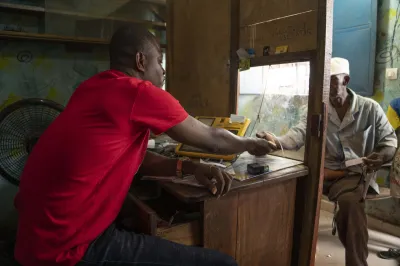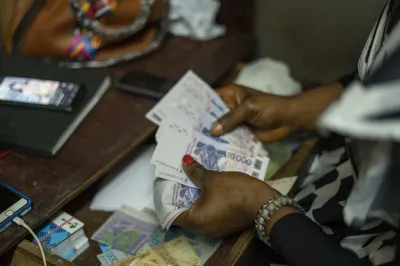COVID-19: A Trigger to Enhance Rural Agent Networks
COVID-19 cash assistance programs around the world have relied heavily on rural agent networks to distribute much-needed cash to their citizens. In the span of just a few months last year, India’s Pradhan Mantri Garib Kalyan Yojana (PMGKY) program distributed $8.8 billion to 428 million people, thanks in part to the country’s cash-in/cash-out agent network. But while the pandemic has underscored the importance of agent networks, it has also exposed significant flaws in their business models.
Importance of last-mile agent networks in the global COVID-19 response
The fact that rural agent networks have been vital to the COVID-19 response is encapsulated by the story an agent named Mohibul told us in Tengabari, a village in Assam, India.
After the country went into lockdown in March of last year, he had planned to close his dedicated agent point for fear of catching the virus. But so many of his low-income customers were coming to him to withdraw PMGKY payments that he didn’t have the heart to refuse them.
"A lot of my customers are old age pensioners, widows or illiterate women, and all of them needed to withdraw PMGKY payments to survive the lockdown."
— Mohibul, an agent in rural India
Instead of closing up, Mohibul kept his store open. Day after day, he would explain to customers how to withdraw cash from his store using Aadhaar-enabled payment services. When they were confused and asked for his help, he would help them. He hasn’t closed a day since the pandemic started.
Around the world, there are many agents like Mohibul who are vital to helping governments deliver emergency assistance.
Agents’ reliance on remittance revenues places them in precarious position as remittances decline globally
Government cash transfer programs have proven to be a lifeline of sorts not only for the customers of agents like Mohibul, but also for agents themselves.
In the early months of the pandemic, some countries classified agents as “essential service providers” and waved charges on digital transactions. Making these transactions free incentivized customers to use digital payments more often for things like utility bill payments. For example, total transactions on India’s nationwide, interoperable Aadhaar-enabled payment system more than doubled from 172 million in March 2020 to 403 million in April 2020, when the first tranche of PMGKY payments were transferred to people’s bank accounts. Greater transaction volumes are a boon to agents, who generate revenue from commissions that providers pay them for cash-in or cash-out.
However, not all agents have benefitted from these programs. In Kenya and Indonesia, for example, the government delivered social assistance benefits only through selected bank agents — a small proportion of the country’s agents. Moreover, agents who have benefited from social assistance programs have seen their revenue reduced by the additional costs associated with liquidity management and sanitizing their outlets.
Above all, whatever revenues rural agents have earned from emergency cash transfer programs appear to have been more than offset, in most cases, by disruptions to their main source of revenue: remittances.
Global data show that domestic remittances from cities to rural areas plummeted last year. When urban workers lose their jobs, they have little money to send family members in rural areas. But international remittances to low- and middle-income countries are down too. Last year, they declined 7.2 percent to $508 billion (the sharpest decline in recent history) and are projected to decline another 7.5 percent to $470 billion this year. India saw migrant remittance inflows drop from $83 million in October 2019 to $75 million in October 2020.
Using data on India’s Immediate Payment Service (IMPS) transactions during the lockdown (a proxy to measure domestic remittance flows), we can understand the significant drop-off in the country’s remittance (money transfer) transactions.
In countries like India and Indonesia, agents report that revenues from government-to-person emergency cash transfers have significantly offset the drop-off in remittances and helped to stabilize their incomes. However, agent viability across countries such as Kenya and Uganda dropped sharply as agents’ other and often primary business activities, such as running corner stores, suffered and remittance revenues dropped.
Rural agents’ heavy dependence on remittance transactions exposes a lack of diversity in their business model that threatens the viability of agent networks when they are most needed during a crisis.
As another agent from Assam, India, told us: “I used to get 200 to 250 customers daily primarily for remittance service (money transfer), but since the lockdown most of my customers moved back to their home as work dried up. Now, on a good day, I get 30-40 customers.”
Rural agents’ heavy dependence on remittance transactions exposes a lack of diversity in their business model that threatens the viability of agent networks when they are most needed during a crisis.
COVID-19 has exposed other vulnerabilities in agent networks too
In addition to weakening the financial incentives for rural storeowners to continue serving as agents, COVID-19 has made it more difficult for them to operate. In Kenya, agents reported that they were struggling to manage liquidity amid declines in cashflow from their secondary businesses. Agents in India, especially women, indicated that mobility constraints affect their ability to rebalance cash and continue serving their customers.
Beyond liquidity management challenges, the pandemic has strained the communication systems between financial services providers, agent network managers and agents. Agents in India have reported that it is difficult for them to raise complaints with agent network managers. Response time for grievance redressal increased from 11 to 20 hours for agents in India. In Indonesia, 1 in 10 agents states that complaint resolution takes “an unusual amount of time.” Similarly, agents in Uganda report difficulty accessing call centers to resolve grievances and feeling concerned about the long-term impact on customer’s trust in mobile money services. This will become an issue if agents no longer feel they are able to assist customers in getting their issues resolved.
Agent network managers have responded to these communication challenges by relying more on digital tools like WhatsApp, Telegram and Zoom for regular interactions, remote agent onboarding and training. Some agents are also changing the way they communicate, using social media to interact with customers who need assistance with transactions.
Steps that can be taken to strengthen last-mile agent networks
COVID-19 has highlighted these weaknesses, but financial services providers and agent network managers can take steps to improve the viability of their agents.
One important measure is for providers to diversify services offered at their agent points. Service aggregation could create opportunities for agents to cater to the needs of different target segments, stabilizing their digital financial service revenue stream. It is equally important offer regular trainings and user-friendly educational materials that equip agents to sell these offerings to their customers in a secure environment. A good example of this is MSC’s comics for training cash-in/cash-out agents on managing operations during COVID-19.
To improve the financial incentives for agents, agent network managers should design comprehensive compensation structures considering an agent’s location, demand for services in the area, typical transaction mixes and existing infrastructure. They should pass a high proportion of their commissions to agents and communicate their commission rates clearly. In the long term, providers will need to change their commission structures to incentivize clients to keep their money digital in preference to cashing out.
To help with liquidity, managers should increase agent transaction or e-float limits based on anticipated demand and agents’ historical transaction records. By partnering with fintech platforms, they could provide affordable loans or overdraft facilities with flexible terms and conditions.
Finally, managers should digitize their agent management systems to implement agile agent onboarding, digital training and effective grievance resolution systems to improve efficiency in operations.




Add new comment